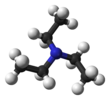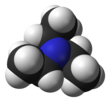إثيلامين ثلاثي

| |||
|
| |||
| الأسماء | |||
|---|---|---|---|
| اسم أيوپاك المفضل
N,N-Diethylethanamine | |||
| أسماء أخرى
(Triethyl)amine
Triethylamine (no longer IUPAC name[1]) | |||
| المُعرِّفات | |||
| رقم CAS | |||
3D model (JSmol)
|
|||
| اختصارات | TEA[2] | ||
| مرجع بايلستاين | 605283 | ||
| ChEBI | |||
| ChEMBL | |||
| ChemSpider | |||
| ECHA InfoCard | 100.004.064 | ||
| رقم EC |
| ||
| KEGG | |||
| عناوين مواضيع طبية MeSH | |||
PubChem CID
|
|||
| رقم RTECS |
| ||
| UNII | |||
| UN number | 1296 | ||
CompTox Dashboard (EPA)
|
|||
| |||
| |||
| الخصائص | |||
| الصيغة الجزيئية | C6H15N | ||
| كتلة مولية | 101.19 g mol-1 | ||
| المظهر | Colourless liquid | ||
| الرائحة | Fishy, ammoniacal | ||
| الكثافة | 0.7255 g mL−1 | ||
| نقطة الانصهار | |||
| نقطة الغليان | |||
| log P | 1.647 | ||
| ضغط البخار | 6.899–8.506 kPa | ||
| kH | 66 μmol Pa−1 kg−1 | ||
| الحموضة (pKa) | 10.75 (for the conjugate acid) (H2O), 9.00 (DMSO)[3] | ||
| القابلية المغناطيسية | -81.4·10−6 cm3/mol | ||
| معامل الانكسار (nD) | 1.401 | ||
| الكيمياء الحرارية | |||
| الإنتالپية المعيارية للتشكل ΔfH |
−169 kJ mol−1 | ||
| الانتالبية المعيارية للاحتراق ΔcH |
−4.37763 to −4.37655 MJ mol−1 | ||
| سعة الحرارة النوعية، C | 216.43 J K−1 mol−1 | ||
| المخاطر | |||
| ن.م.ع. مخطط تصويري |   
| ||
| ن.م.ع. كلمة الاشارة | DANGER | ||
| H225, H302, H312, H314, H332 | |||
| P210, P280, P305+P351+P338, P310 | |||
| NFPA 704 (معيـَّن النار) | |||
| نقطة الوميض | −15 °C (5 °F; 258 K) | ||
| 312 °C (594 °F; 585 K) | |||
| حدود الانفجار | 1.2–8% | ||
| 2 ppm (8 mg/m3) (TWA), 4 ppm (17 mg/m3) (STEL) | |||
| الجرعة أو التركيز القاتل (LD, LC): | |||
LD50 (الجرعة الوسطى)
|
| ||
LCLo (المنشورة الأقل)
|
1425 ppm (mouse, 2 hr)[5] | ||
| حدود التعرض الصحية بالولايات المتحدة (NIOSH): | |||
PEL (المسموح)
|
TWA 25 ppm (100 mg/m3)[4] | ||
REL (الموصى به)
|
None established[4] | ||
IDLH (خطر عاجل)
|
200 ppm[4] | ||
| مركبات ذا علاقة | |||
amines ذات العلاقة
|
|||
مركـّبات ذات علاقة
|
|||
ما لم يُذكر غير ذلك، البيانات المعطاة للمواد في حالاتهم العيارية (عند 25 °س [77 °ف]، 100 kPa). | |||
| مراجع الجدول | |||
إثيلامين ثلاثي أو ترايإثيلامين Triethylamine هو مركب كيميائي صيغته N(CH2CH3)3, commonly abbreviated Et3N. It is also abbreviated TEA, yet this abbreviation must be used carefully to avoid confusion with triethanolamine or tetraethylammonium, for which TEA is also a common abbreviation.[6][7] It is a colourless volatile liquid with a strong fishy odor reminiscent of ammonia. Like diisopropylethylamine (Hünig's base), triethylamine is commonly employed, usually as a base, in organic synthesis.
التخليق والخصائص
Triethylamine is prepared by the alkylation of ammonia with ethanol:[8]
- NH3 + 3 C2H5OH → N(C2H5)3 + 3 H2O
The pKa of protonated triethylamine is 10.75,[3] and it can be used to prepare buffer solutions at that pH. The hydrochloride salt, triethylamine hydrochloride (triethylammonium chloride), is a colorless, odorless, and hygroscopic powder, which decomposes when heated to 261 °C.
Triethylamine is soluble in water to the extent of 112.4 g/L at 20 °C.[9] It is also miscible in common organic solvents, such as acetone, ethanol, and diethyl ether.
Laboratory samples of triethylamine can be purified by distilling from calcium hydride.[10]
In alkane solvents triethylamine is a Lewis base that forms adducts with a variety of Lewis acid such as I2 and phenols. Owing to its steric bulk, it forms complexes with transition metals reluctantly.
التطبيقات
Triethylamine is commonly employed in organic synthesis as a base. For example, it is commonly used as a base during the preparation of esters and amides from acyl chlorides.[11] Such reactions lead to the production of hydrogen chloride which combines with triethylamine to form the salt triethylamine hydrochloride, commonly called triethylammonium chloride. This reaction removes the hydrogen chloride from the reaction mixture, which can be required for these reactions to proceed to completion (R, R' = alkyl, aryl):
- R2NH + R'C(O)Cl + Et3N → R'C(O)NR2 + Et3NH+Cl−
Like other tertiary amines, it catalyzes the formation of urethane foams and epoxy resins. It is also useful in dehydrohalogenation reactions and Swern oxidations.
Triethylamine is readily alkylated to give the corresponding quaternary ammonium salt:
- RI + Et3N → Et3NR+I−
Triethylamine is mainly used in the production of quaternary ammonium compounds for textile auxiliaries and quaternary ammonium salts of dyes. It is also a catalyst and acid neutralizer for condensation reactions and is useful as an intermediate for manufacturing medicines, pesticides and other chemicals.
Triethylamine salts like any other tertiary ammonium salts are used as an ion-interaction reagent in ion interaction chromatography, due to their amphiphilic properties. Unlike quaternary ammonium salts, tertiary ammonium salts are much more volatile, therefore mass spectrometry can be used while performing analysis.
استخدامات صغيرة
Triethylamine is used to give salts of various carboxylic acid-containing pesticides, e.g. Triclopyr and 2,4-dichlorophenoxyacetic acid[بحاجة لمصدر]
Triethylamine is the active ingredient in FlyNap, a product for anesthetizing Drosophila melanogaster.[بحاجة لمصدر] Triethylamine is used in mosquito and vector control labs to anesthetize mosquitoes. This is done to preserve any viral material that might be present during species identification.
Also, the bicarbonate salt of triethylamine (often abbreviated TEAB, triethylammonium bicarbonate) is useful in reverse phase chromatography, often in a gradient to purify nucleotides and other biomolecules.[بحاجة لمصدر]
Triethylamine was found during the early 1940s to be hypergolic in combination with nitric acid, and was considered a possible propellant for early hypergolic rocket engines.[12]
التواجد الطبيعي
Hawthorn flowers have a heavy, complicated scent, the distinctive part of which is triethylamine, which is also one of the first chemicals produced by a dead human body when it begins to decay. For this reason, it is considered unlucky to bring hawthorn into a house. Gangrene and semen are also said to possess a similar odour.[13]
المراجع
- ^ "Front Matter". Nomenclature of Organic Chemistry : IUPAC Recommendations and Preferred Names 2013 (Blue Book). Cambridge: The Royal Society of Chemistry. 2014. p. 671. doi:10.1039/9781849733069-FP001. ISBN 978-0-85404-182-4.
- ^ X. Bories-Azeau, S. P. Armes, and H. J. W. van den Haak, Macromolecules 2004, 37, 2348 PDF
- ^ أ ب David Evans Research Group Archived 2012-01-21 at the Wayback Machine
- ^ أ ب ت NIOSH Pocket Guide to Chemical Hazards 0633
- ^ "Triethylamine". Immediately Dangerous to Life or Health Concentrations (IDLH). National Institute for Occupational Safety and Health (NIOSH).
- ^ "Ethanolamine Compounds (MEA, DEA, TEA And Others)". Safe Cosmetics (in الإنجليزية الأمريكية). Retrieved 2020-06-17.
- ^ "tetraethylammonium | Ligand page | IUPHAR/BPS Guide to PHARMACOLOGY". www.guidetopharmacology.org. Retrieved 2020-06-17.
- ^ Eller, Karsten; Henkes, Erhard; Rossbacher, Roland; Höke, Hartmut (2000). Amines, Aliphatic. doi:10.1002/14356007.a02_001. ISBN 3527306730.
- ^ "MSDS - 471283". www.sigmaaldrich.com. Retrieved 2020-06-17.
- ^ F., Armarego, W. L. (2012-10-17). Purification of Laboratory Chemicals. Chai, Christina Li Lin (Seventh ed.). Amsterdam. ISBN 9780123821621. OCLC 820853648.
{{cite book}}: CS1 maint: location missing publisher (link) CS1 maint: multiple names: authors list (link) - ^ Sorgi, K. L. (2001). "Triethylamine". Encyclopedia of Reagents for Organic Synthesis. New York: John Wiley & Sons. doi:10.1002/047084289X.rt217. ISBN 978-0471936237.
- ^ Clark, John (1972). Ignition!: An Informal History of Liquid Rocket Propellants (PDF). Rutgers University, the State University of New Jersey. p. 13. ISBN 0-8135-0725-1.
- ^ The book of general ignorance. John Lloyd & John Mitchinson. Faber & Faber 2006, The Hawthorn, BBC
وصلات خارجية
- CS1 الإنجليزية الأمريكية-language sources (en-us)
- CS1 maint: location missing publisher
- Articles with hatnote templates targeting a nonexistent page
- ECHA InfoCard ID from Wikidata
- Articles containing unverified chemical infoboxes
- Chembox image size set
- Short description is different from Wikidata
- Articles with unsourced statements from July 2018
- ألكيلات الأمين
- أمينات ثالثية


